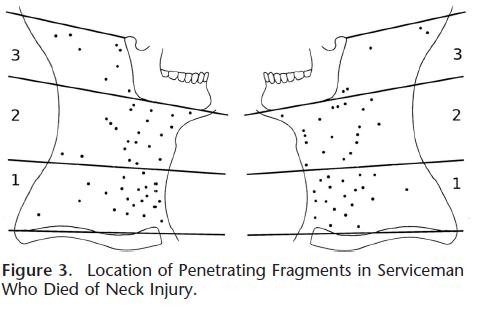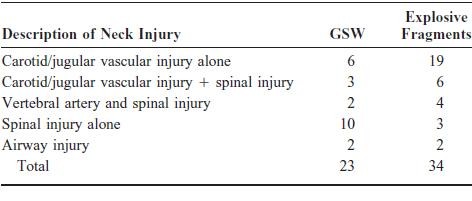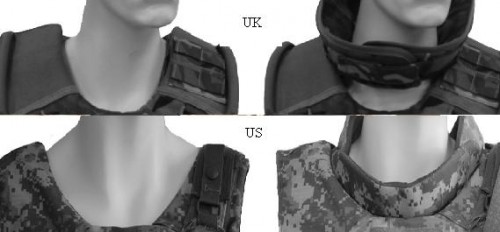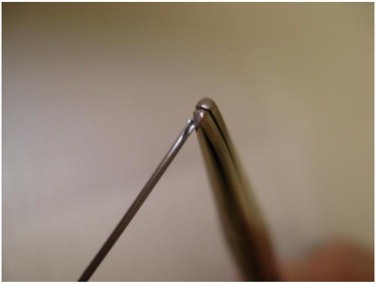15/04/2012
Water Requirements and Soldier Hydration
14/04/2012
Battle mind training: De la maison à la zone de combat, Pourquoi ?
| Tags : psychiatrie, ptsd
13/04/2012
Les plaies du cou: Danger
Mortality and morbidity from combat neck injury
Breeze J. et all. J Trauma. 2012;72: 969–974.
-----------------------------------------------------------------------------------
BACKGROUND:
Neck injury represents 11% of battle injuries in UK forces in comparison with 2% to 5% in US forces. The aim of this study was to determine the causes of death and long-term morbidity from combat neck injury in an attempt to recommend new methods of protecting the neck.
METHOD:
Hospital and postmortem records for all UK servicemen sustaining battle injuries to the neck between January 1, 2006 and December 31, 2010 were analyzed.
RESULTS:
Neck wounds were found in 152 of 1,528 (10%) of battle injured service personnel. Seventy-nine percent of neck wounds were caused by explosions and were associated with a mortality rate of 41% compared with 78% from gunshot wounds (GSWs). Although current UK OSPREY neck collars can potentially protect zone I from explosive fragments, in the 58% in which the wearing of a neck collar was known, all service personnel chose not to wear the collar. The most common cause of death from explosive fragments was vascular injury (85%). Zone II was the most commonly affected area overall by explosive fragments and had the highest mortality but zone I was associated with the highest morbidity in survivors.
CONCLUSIONS:
Nape protectors, that cover zone III of the neck posteriorly, would only have potentially prevented 3% of injuries and therefore this study does not support their use. Current UK OSPREY neck collars potentially protect against the majority of explosive fragments to zones I and II and had these collars been worn potentially 16 deaths may have been prevented. Reasons for their lack of uptake by UK servicemen is therefore being evaluated. Surface wound mapping of penetrating explosive fragments in our series has been used to validate the area of coverage required for future designs of neck protection.
-----------------------------------------------------------------------------------
1. Des lésions essentiellement antérieures
2. Une atteinte surtout des zones 1 et 2
3. 28% des décédés sont porteurs de lésions cervicales en rapport direct avec le décès dans 73% des cas.
4. Des causes de décès différentes en fonction du type lésionnel
5. Un manque d' adhésion au port de la protection qui expliquerait cette fréquence, une histoire d'ergonomie ?
Du même auteur: Lire aussi
11/04/2012
Prise en charge des victimes d'avalanche ?
ICAR MEDCOM guidelines 2002
Il s'agit des recommandations de l'International Commission for Alpine Emergency Medicine
http://users.south-tyrolean.net/avalanche/pdf/Guidelines_...
Accidental Hypothermia
Accidental Hypothermia
Davis PR et all. J R Army Med Corps 2006; 152: 223-233
Une revue générale sur la prise en charge des hypothermies accidentelles. Il y en a d'autres mais son intérêt est d'être rédigée par nos collègues anglais
http://www.ramcjournal.com/2005/hostile_environments/davi...
07/04/2012
Coniotomie et analyse cognitive de taches
L’analyse cognitive de tâches est une « famille de techniques de recueil de connaissances qui ont démontrées leur efficacité pour extraire les processus cognitifs, décisionnels et de jugements inobservables impliqués lors d’une performance d’expert» (Yates 2007). L’intérêt de ce groupe de techniques est de rendre accessible à la conscience l’ensemble des étapes réalisées de façon automatiques par des experts.
Cette méthode moderne d'enseignement est très certainement d'un apport capital pour l'enseignement du sauvetage au combat. Ainsi il semble qu'elle peut s'appliquer à la coniotomie. C'est du moins ce que laisse supposer l'article suivant.
The effectiveness of a cognitive task analysis informed curriculum to increase self-efficacy and improve performance for an open cricothyrotomy.
Campbell J.. et all J Surg Educ. 2011 Sep-Oct;68(5):403-7
Abstract
OBJECTIVE:
This study explored the effects of a cognitive task analysis (CTA)-informed curriculum to increase surgical skills performance and self-efficacy beliefs for medical students and postgraduate surgical residents learning how to perform an open cricothyrotomy.
METHODS:
Third-year medical students and postgraduate year 2 and 3 surgery residents were assigned randomly to either the CTA group (n = 12) or the control group (n = 14). The CTA group learned the open cricothyrotomy procedure using the CTA curriculum. The control group received the traditional curriculum.
RESULTS:
The CTA group outperformed the control group significantly based on a 19-point checklist score (CTA mean score: 17.75, standard deviation [SD] = 2.34; control mean score: 15.14, SD = 2.48; p = 0.006). The CTA group also reported significantly higher self-efficacy scores based on a 140-point self-appraisal inventory (CTA mean score: 126.10, SD = 16.90; control: 110.67, SD = 16.8; p = 0.029).
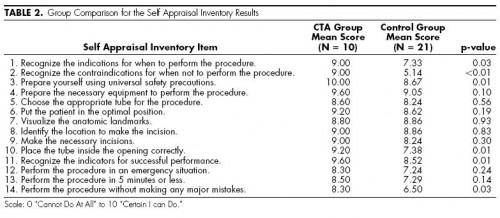
CONCLUSIONS:
The CTA curriculum was effective in increasing the performance and self-efficacy scores for postgraduate surgical residents and medical students performing an open cricothyrotomy.
| Tags : airway, coniotomie
06/04/2012
Echographie Pulmonaire
Glissement pleural
https://www.youtube.com/watch?v=HD7JzLg33nE
Pneumothorax
https://www.youtube.com/watch?v=7bK_C9NyrAc
Epanchement
04/04/2012
Enlever un corps étranger cornéen
Corneal foreign body removal using a bent needle tip
Beyer H et all. Am J Emerg Med. 2012 Mar;30(3):489-90
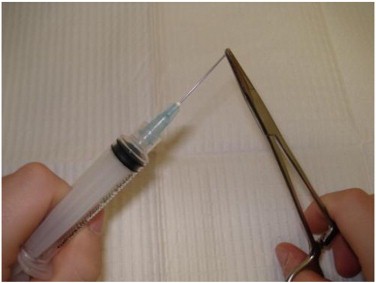
http://www.annals.edu.sg/pdf/40VolNo10Oct2011/V40n10p469....

